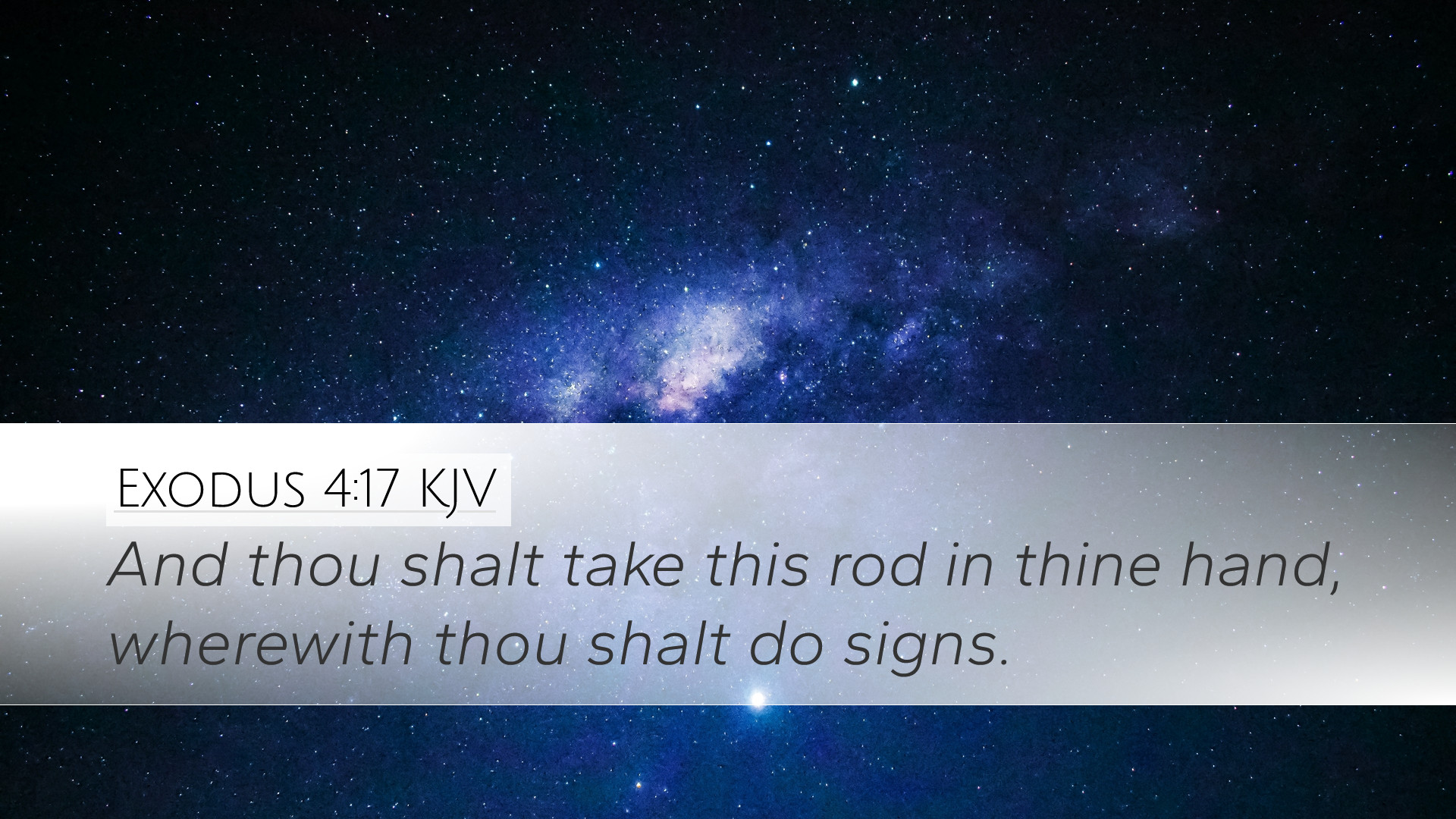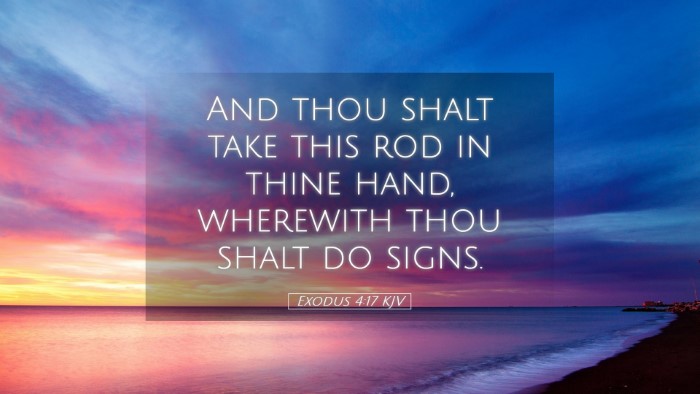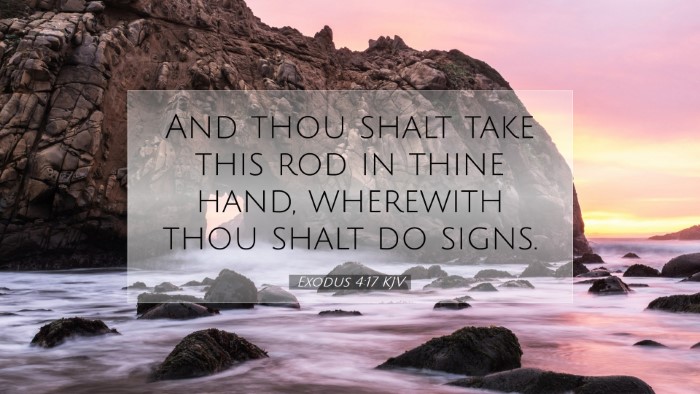Exodus 4:17 Commentary
Bible Verse: “And thou shalt take this rod in thine hand, wherewith thou shalt do signs.” (Exodus 4:17)
Introduction
The verse Exodus 4:17 occupies a critical place in the narrative of Moses’ call and preparation for his mission to deliver the Israelites from Egyptian bondage. This directive from God emphasizes the symbolic and practical significance of the rod that Moses is instructed to carry. Various commentaries provide insights that enrich our understanding of this verse, its implications for leadership, and its theological ramifications.
Contextual Analysis
Exodus 4 marks a pivotal moment in Moses' life as God appoints him as the leader of His people. After Moses’ initial reluctance and questioning, God assures him of His presence and the authority he will wield. The rod serves not just as a physical instrument but as a vital emblem of divine power and authority that will be manifest in miraculous signs.
Insights from Public Domain Commentaries
Matthew Henry's Commentary
Matthew Henry emphasizes the rod as a means of God's miraculous power. He interprets this object as a tool through which God enables Moses to perform signs that will demonstrate His sovereignty and establish Moses’ authority before the people of Israel and Pharaoh.
- Symbol of Authority: Henry notes that the rod represents the authority with which Moses is charged. God’s command to use the rod illustrates that the power comes not from Moses himself but through his obedience to God’s command.
- God’s Assurance: The rod is a tangible assurance for Moses, reminding him that he is not alone in this calling. Through this object, he can invoke divine will and perform signs that testify to God’s glory.
- Preparation for Leadership: The use of the rod prepares Moses for leadership as it continually points to God's involvement and the necessity of faith in carrying out His plans.
Albert Barnes' Notes
In his commentary, Albert Barnes explores the literal and metaphorical meanings of the rod. He suggests that this rod is not merely a staff but becomes a significant instrument in the unfolding narrative of Exodus.
- Divine Instrumentality: Barnes points out that the rod signifies the principle of divine instrumentality where God empowers ordinary objects and individuals to accomplish extraordinary tasks.
- Operational Symbol: The rod's role in miracles, from turning into a serpent to parting the Red Sea, shows the transformation from ordinary to extraordinary under God’s command.
- Challenges in Leadership: He also contemplates the challenges Moses faces, underscoring that while he has been given the rod, his success is contingent on his faith in God’s promises.
Adam Clarke's Commentary
Adam Clarke elaborates on the significance of the rod within the broader context of Israel’s deliverance. He details how it plays a critical role in various miraculous events.
- Instrument of Signs: Clarke addresses the importance of the rod in performing signs, reiterating that this command represents God's delegation of authority to Moses. The miracles would serve as verification of Moses’ mission and God's power.
- The Nature of God's Signs: He contemplates that these signs are not mere acts but are meant to provoke thought and evoke belief among the people of Israel and their captors, establishing a basis for faith in God's impending deliverance.
- Encouragement for Believers: Clarke's commentary encourages readers to view the rod as a symbol of the resources God provides to His leaders, emphasizing that believers are equipped with divine reinforcement in their ministries.
Theological Implications
The command to take the rod not only illustrates the principle that God uses instruments of His choosing but also signifies the theme of empowerment that runs throughout Scripture. Here are some implications highlighted by the commentators:
- Faith and Action: The rod reflects the intertwining of faith and action, where Moses must act upon God’s command, demonstrating trust.
- God’s Sovereignty: This moment reveals God’s sovereignty in delivering His people. The rod becomes an emblem through which divine authority is expressed, inviting reflections on how God operates in the world through seemingly ordinary means.
- Leadership and Responsibility: For pastors and leaders, this verse serves as a reminder of the divine authority bestowed upon them; they are to carry out God’s commands, not by their strength but through the power of God.
Conclusion
Exodus 4:17 stands as a critical verse that encapsulates themes of divine empowerment and the responsibilities of leadership. The insights drawn from the commentaries of Matthew Henry, Albert Barnes, and Adam Clarke collectively enhance our understanding of how God prepares and equips His chosen leaders. The rod in Moses’ hand is a potent reminder that God can use the simple and mundane to accomplish His extraordinary purposes. Pastors, students, and scholars are encouraged to reflect on what ‘rod’ God has placed in their hands and how they might leverage it for His glory.


